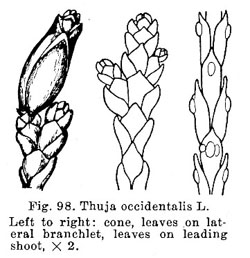Thuja occidentalis
 American arborvitae
American arborvitae

The leaves, which have a pleasant scent when crushed, are in the form of small overlapping scales hugging branchlets arranged in flat sprays disposed more or less horizontally. Numerous horticultural varieties are available, including variegated, golden, and dwarf forms. The cones are about ½ inch long. The commercially important lumber is traded as northern white cedar. American arborvitae has been known as white cedar, a name that is also applied to incense cedar, Port Orford cedar, California juniper, and other trees.
No campus locations are known, though Albert Wilson gives several in the area (Distinctive Trees, Shrubs, and Vines in the Gardens of the San Francisco Peninsula, 1938).
Illustrations: cone comparisons of Thuja species.
Name derivation: Thuja – Greek name thuia for a type of juniper; occidentalis – western.
About this Entry: The main text of this entry is from the book Trees of Stanford and Environs, by Ronald Bracewell, published 2005. Historic Arboretum planting note and some locations moved over to Platycladus orientalis entry; there is no record of T. occidentalis on campus (May 2024, SP).



